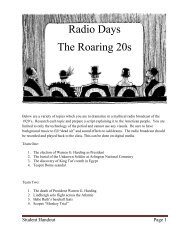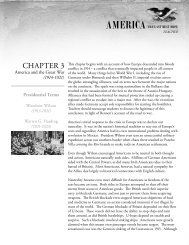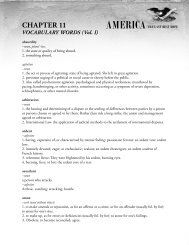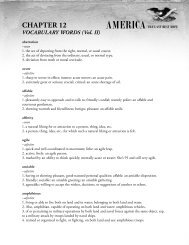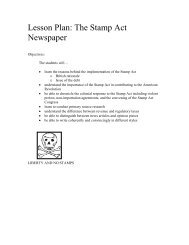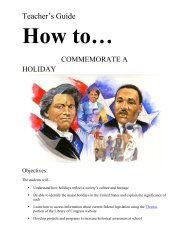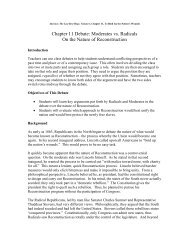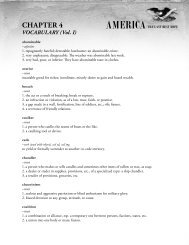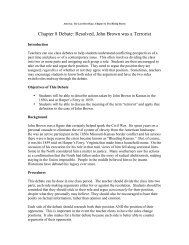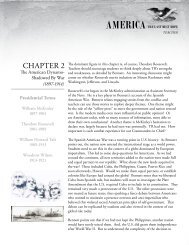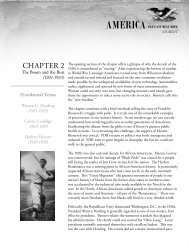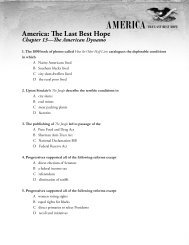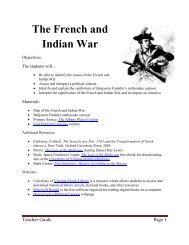Lesson Plan - Billy Joel's "We Didn't Start the Fire"
Lesson Plan - Billy Joel's "We Didn't Start the Fire"
Lesson Plan - Billy Joel's "We Didn't Start the Fire"
Create successful ePaper yourself
Turn your PDF publications into a flip-book with our unique Google optimized e-Paper software.
Background:<br />
Song writer <strong>Billy</strong> Joel is a talent musician and lyricist. Many of his songs have outstanding<br />
historical <strong>the</strong>mes that can be used in <strong>the</strong> classroom. Music helps students retain information and<br />
can increase <strong>the</strong>ir understanding of events. In 1989, Joel wrote a popular song called “<strong>We</strong> Didn’t<br />
<strong>Start</strong> <strong>the</strong> Fire” in conjunction with his 40 th birthday. He recalled all of <strong>the</strong> people and events that<br />
impacted his life as a “baby-boomer” growing up during <strong>the</strong> Cold War era. The song is now<br />
readily available on CD, Itunes, and DVD and has <strong>the</strong> added advantage of <strong>the</strong> fact that most<br />
students have never heard it.<br />
1. Introduce <strong>the</strong> song and activity to <strong>the</strong> classroom.<br />
a. Provide <strong>the</strong> students some context to <strong>the</strong> Cold War.<br />
b. Why is 1989 considered to be <strong>the</strong> unofficial end of <strong>the</strong> Cold War?<br />
i. Explain <strong>the</strong> events surrounding <strong>the</strong> tearing down of <strong>the</strong> Berlin Wall and<br />
<strong>the</strong> subsequent collapse of Communism in <strong>the</strong> Soviet Union.<br />
2. Pass out <strong>the</strong> handout with <strong>the</strong> listing of <strong>the</strong> major figures in <strong>the</strong> song.<br />
3. Play <strong>the</strong> song for <strong>the</strong> class.<br />
a. The DVD version is excellent but <strong>the</strong>re is a very brief scene of drug use but this is<br />
not gratuitous but in context of <strong>the</strong> period.<br />
4. Assign each student two names from <strong>the</strong> list randomly.<br />
a. Have <strong>the</strong> students research <strong>the</strong> individual and his/her significance.<br />
b. Why was that person included in <strong>the</strong> song?<br />
c. What was <strong>the</strong> timeframe of that individual’s fame?<br />
i. Note that some of <strong>the</strong> people have long careers. The song is roughly<br />
chronological from 1949 “Harry Truman” to 1987 “Bernie Geotz.”<br />
d. You may want to have <strong>the</strong> students prepare posters or o<strong>the</strong>r materials to hang<br />
around <strong>the</strong> classroom to illustrate <strong>the</strong> song.<br />
5. You may also want to <strong>the</strong>n have <strong>the</strong> students research some of <strong>the</strong> events portrayed in <strong>the</strong><br />
song as well.<br />
6. There are several websites available for <strong>the</strong> song. YouTube has some excellent videos<br />
illustrating it as well.<br />
7. If time permits, you may want to play/show <strong>the</strong> <strong>Billy</strong> Joel songs “Leningrad” and<br />
“Allentown.”<br />
a. “Leningrad” shows <strong>the</strong> hostility between <strong>the</strong> United States and <strong>the</strong> Cold War.<br />
b. “Allentown” portrays <strong>the</strong> growth of <strong>the</strong> suburbs and its homogenized culture.<br />
c. “Goodnight Saigon” is Joel’s portrayal of <strong>the</strong> Vietnam War.<br />
Teacher Guide Page 2



